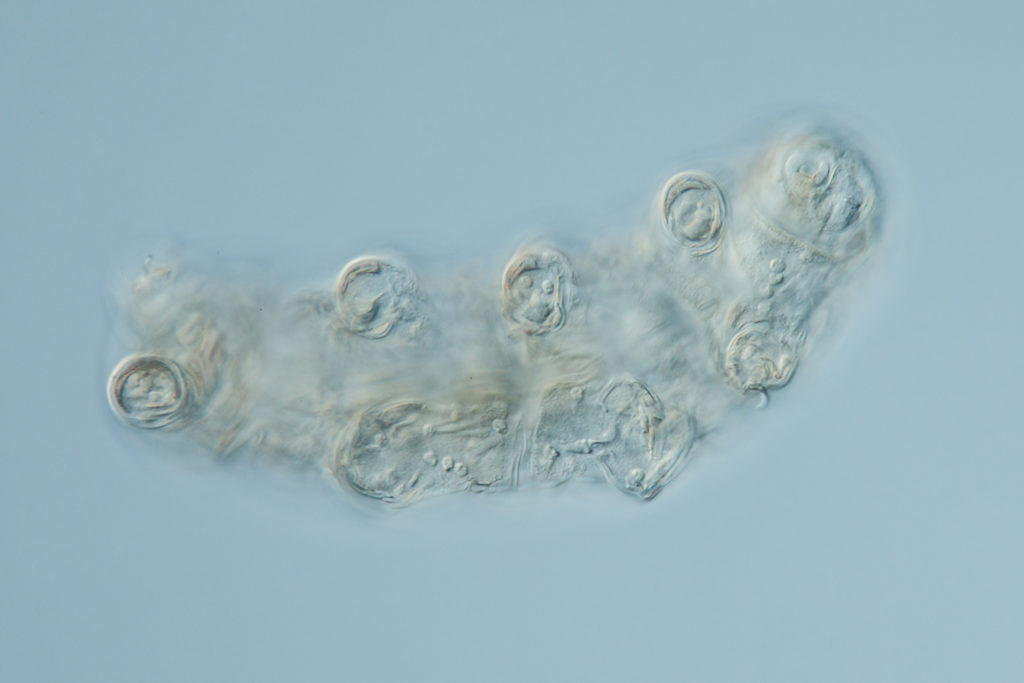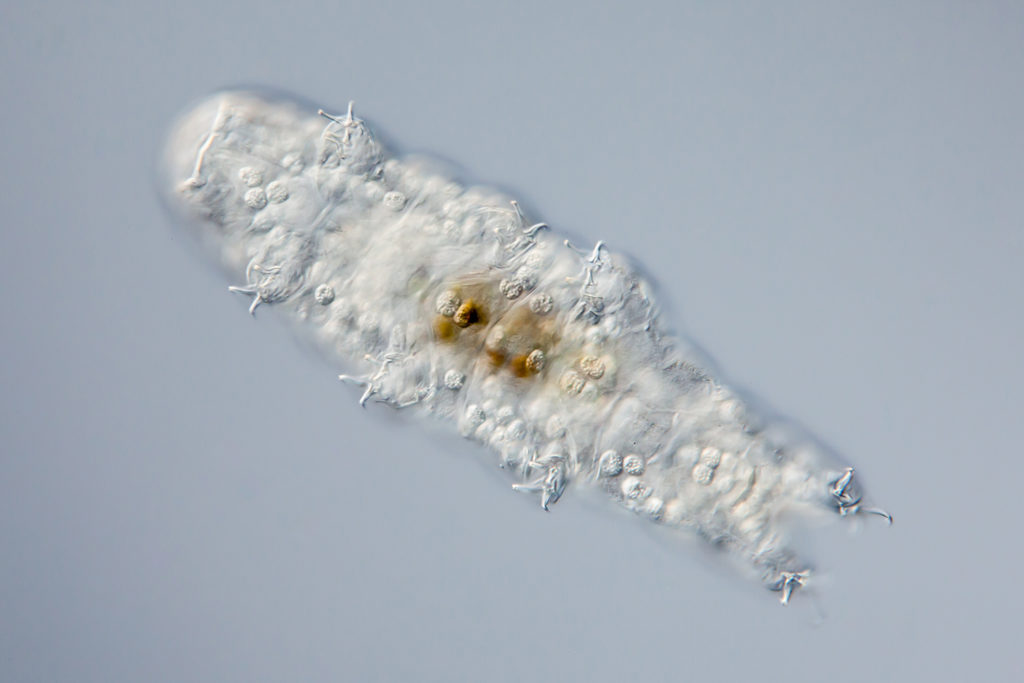Module/Week 3
Micro Animals
Laboratory & Media Piece

Micro Animals Objective:
Thoroughly describe with original media four different types of micro animals to someone who may be unaware these type of animals exist.
Information from previous parts of the course can be helpful in completing this assignment.
Background Information for Lab & Media Piece
Background Material

All of the micro animals in this week’s lab are found in water. Some stay microscopic like the rotifer in this photo, other species like planaria flatworms in the next photo grow large enough to see without magnification. All start their lives under one millimeter in size, some species can grow almost a centimeter in size.
This lab features eight different micro animal species, although other species may pop up in videos or in photo backgrounds. You can select four to study for your lab media piece.

Hydra

There are many hydra species, in lab we are studying the brown hydra and green hydra (40x). These are classified in Phylum Cnidaria, which contains animal species with stinging cells, like jellyfish and coral.
Brown Hydra (Hydra oligactis) are found in freshwater lakes and ponds throughout the temperate areas of the Northern Hemisphere, including here in the Willamette Valley. They are easiest to find attached to plants in small ponds spring through autumn. Hydra catch and eat smaller animals like daphnia and rotifers.

Rotifers

Rotifer animals (400x) of Phylum Rotifera remain microscopic their entire lives. Their mouths are surrounded by hair-like cilia that move the animals and direct food into the mouth. The rapidly swirling cilia give rotifers the common name of “wheel animals.” Rotifer species come in many shapes, and move in different recognizable patterns.
Approximately 2000 species of rotifers have been identified and they eat a variety of smaller organisms. Some species primarily eat algae, others consume animal-like protists. Many species are likely omnivores. Rotifers are eaten themselves by many larger animal species and serve an important role in aquatic food webs.

Daphnia

Daphnia (Daphnia sp.), also called water fleas, are one of the two species we have in this lab classified as Branchiopod Crustaceans (along with fairy shrimp). Crustaceans are arthropods with gills and include larger shrimp, lobsters, and isopods. Branchiopods are small, freshwater crustacean animals that feed on smaller organisms and detritus.
Daphnia range from 0.1 mm to 6 mm in size, so adults can be visible without magnification. Long appendages enable daphnia to swim through the water, often with a “jerky” movement as the appendages contract. Many larger animals rely on daphnia as a food source,

The daphnia in this video are active, responding to the lit areas of the water.
When the light is moved to one corner, the daphnia follow.
Fairy Shrimp

Fairy Shrimp (40x) are classified as Branchiopod Crustaceans like daphnia. However, fairy shrimp have a different body shape, more similar to larger crustaceans like crayfish or shrimp. Fairy shrimp species that live in vernal “spring” ponds that temporarily form with rainwater. These crustaceans hatch, grow, reproduce, and lay eggs before their ephemeral ponds dry up.
Over 300 species of Fairy Shrimp (Genus Anostraca) have been identified. Fairy Shrimp have several leg-like appendages that contract together in an undulating motion. These animals filter algae and small bits of detritus out of the water. Although they start small, some species have adults that grow over an inch in length.

Tardigrades

Tardigrades (40x)
In recent years Tardigrades or “water bears” have received a lot of media attention because they can survive in extreme environments, even potentially the Moon.


Tardigrades have small legs that “walk” through water and on the mosses or sandy beaches they are often found in. Even though they look like a microscopic bear to some, they are so different than other species, they have been classified in their own invertebrate phylum: Phylum Tardigrada.
Tardigrades may be micro animals, but they still have organs that will sound familiar, even if they are smaller and simpler in structure. Full-grown length is only about 0.5 mm. Tardigrades typically consume plants or bacteria and are themselves eaten by many larger animals.

Planaria

Planaria (40x) are flatworms in Phylum Platyhelminthes, one of several worm phyla. Basically, there are a lot of types of worms! Brown Planaria (Dugesia tigrina) and Black Planaria (Phagocata gracilis) live in freshwater and are carnivores that eat snails, isopods, and aquatic larvae.
Two eyespots have photoreceptor cells that detect light. Planaria contract their body to move and also have many small cilia on their dorsal (bottom) side that make them seem to glide along objects. Put food in front of them and they can chemically sense their prey and quickly move in to feed. If attacked and injured, a small piece of a planaria can regenerate into an entire organism.

The planaria in this video are mostly sitting still, except two along the water line moving left. They have all just been fed a cooked egg yolk meal.
Nematode

Nematode roundworms (100x) are classified in their own Phylum Nematoda, a different type of worm than the flatworms or annelids. Nematodes can be found in aquatic and terrestrial systems, and even within larger animals as parasites. We will be looking at nematodes living in freshwater.
If you see a tiny almost translucent worm wiggling in a sample of pond water or washed off of wet moss, you may be seeing an adult nematode. Under a microscope at low magnification they are some of the most eye-catching animals, muscular and thrashing around. Vinegar Eels are nematodes that can live in acidic (pH 2.0 – 3.0) unfiltered vinegar!

Annelid

The annelids are back! Aelosoma are tiny transparent freshwater worms that are segmented and classified in Phylum Annelidia with the larger red wigglers and nightcrawlers. Often they attach to a pond plant and graze detritus and microorganisms off the surface of the leaves. Small bristle-like projections deter potential predators, but they are still eaten by larger fish.
Assignment (due Sunday on Canvas)
Refer back to Animal Characteristics, Magnify & Measure, Microscopic Animals, and this webpage as needed.
Micro Animals
Many people are unaware that there are “micro animals” living in different environments. For this assignment you are creating original media (photos, sketches, captions, creative writing, video, etc.) that teaches someone about micro animals.
Include in your media piece
-
a description of what an animal is, to distinguish micro animals from other microscopic organisms that are not animals.
-
an explanation of the general size of a micro animal, providing some context for how small they are.
-
a brief description of the magnification process , including why a light source and glass lens are needed (stains may not be used if it is a live animal).
-
examples of four different types of micro animals found in water. Include: their scientific name, body form/shape, what they eat, and any other potentially interesting aspect like behavior or life stage.
Note: we will provide more than four micro animal species to study in lab; you can select the four you want to make media about and include in your assignment.


